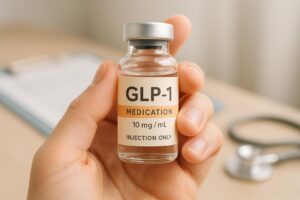Do GLP-1 Lower Cholesterol? Insights into Heart Health Benefits

The connection between our weight, cholesterol levels, and overall heart health can sometimes feel like a complex puzzle. For many of us striving to maintain a healthy lifestyle, understanding how medications can influence these factors is crucial. One class of drugs that has garnered attention in recent years is the glucagon-like peptide-1 receptor agonists (GLP-1 RAs), which are primarily known for their role in managing blood sugar levels in individuals with type 2 diabetes. However, emerging research suggests these medications may also play a significant role in lowering cholesterol levels. So, do GLP-1s lower cholesterol? Together, we will explore this question and delve into the broader implications of these medications for heart health.
Introduction
Did you know that nearly 95 million adults in the United States have high cholesterol levels, putting them at risk for heart disease? As we navigate our health journeys, it’s essential to keep our cholesterol levels in check, as high levels can lead to serious cardiovascular issues. The role of medications, particularly GLP-1 receptor agonists, has sparked interest among healthcare professionals and patients alike.
Initially developed for the treatment of type 2 diabetes, GLP-1 RAs such as Ozempic® and Wegovy® have demonstrated impressive results in weight loss and glucose management. However, recent studies have revealed their potential benefits in improving lipid profiles, including cholesterol levels. In this blog post, we will examine how GLP-1 RAs may lower cholesterol, their mechanisms of action, and the implications for individuals with metabolic disorders.
By the end of this post, you will have a comprehensive understanding of the relationship between GLP-1s and cholesterol management and how these medications fit into the larger picture of cardiovascular health.
Understanding Cholesterol and Its Impact on Health
Before we dive into the specifics of GLP-1 receptor agonists, let’s clarify what cholesterol is and why it matters. Cholesterol is a waxy, fat-like substance found in every cell of the body. It plays a critical role in producing hormones, vitamin D, and substances that help digest foods. However, not all cholesterol is created equal.
There are two primary types of cholesterol: low-density lipoprotein (LDL), often referred to as “bad” cholesterol, and high-density lipoprotein (HDL), known as “good” cholesterol. Elevated levels of LDL cholesterol can lead to plaque buildup in the arteries, increasing the risk of heart disease and stroke. Conversely, HDL cholesterol helps remove LDL from the bloodstream, thus protecting against cardiovascular disease.
Understanding the balance between these two types of cholesterol is vital for maintaining heart health. Lifestyle factors such as diet, exercise, and weight management significantly influence cholesterol levels, but medications can also play a crucial role, especially for those struggling to achieve desired levels through lifestyle changes alone.
The Role of GLP-1 Receptor Agonists
GLP-1 receptor agonists are a class of medications that mimic the action of the GLP-1 hormone, which is naturally produced in the gut. These drugs enhance insulin secretion, suppress glucagon release, and slow gastric emptying, leading to improved glycemic control. Additionally, they promote weight loss by increasing satiety, reducing appetite, and improving overall metabolic health.
Recent studies have shown that GLP-1 RAs can also have a positive impact on cholesterol levels. Research indicates that individuals taking GLP-1 receptor agonists experience significant reductions in total cholesterol, LDL cholesterol, and triglycerides, alongside increases in HDL cholesterol. The following sections will explore the mechanisms behind these effects.
Weight Loss and Cholesterol Management
One of the primary benefits of GLP-1 receptor agonists is their ability to promote weight loss. Weight reduction often leads to improvements in lipid profiles, including lower LDL cholesterol and triglycerides. By addressing obesity, GLP-1s help combat one of the major risk factors for high cholesterol levels.
When we lose weight, our bodies become more sensitive to insulin, which can help regulate cholesterol metabolism. Additionally, weight loss can reduce the production of lipoproteins and chylomicrons, leading to lower levels of triglycerides in the bloodstream. As a result, individuals may experience a significant improvement in their overall cholesterol levels.
Direct Effects on Cholesterol Metabolism
Beyond weight loss, GLP-1 receptor agonists may directly influence cholesterol metabolism. Studies suggest that these medications can enhance the liver’s ability to regulate cholesterol production. GLP-1 RAs signal the liver to decrease cholesterol synthesis while increasing the clearance of LDL cholesterol from the bloodstream.
Moreover, GLP-1 receptor agonists have been shown to upregulate LDL receptors in the liver, promoting the uptake and degradation of LDL particles. This mechanism contributes to the overall reduction in circulating LDL cholesterol levels.
Inflammation and Cardiovascular Health
Inflammation plays a significant role in atherosclerosis, the process by which plaque builds up in the arteries, leading to cardiovascular disease. Some studies indicate that GLP-1 receptor agonists possess anti-inflammatory properties, which could further enhance their lipid-lowering effects. By reducing inflammation in the bloodstream and arterial walls, these medications may help prevent the progression of atherosclerosis.
Research Evidence on GLP-1s and Cholesterol
Several clinical studies have explored the impact of GLP-1 receptor agonists on cholesterol levels. In a meta-analysis of randomized clinical trials, researchers found that treatment with GLP-1 RAs resulted in significant reductions in total cholesterol and LDL cholesterol compared to placebo groups.
For instance, a study published in the New England Journal of Medicine revealed that participants taking semaglutide (a GLP-1 RA) experienced a 4.6% reduction in total cholesterol and a 5.3% decrease in LDL cholesterol over a year. These findings were consistent across various patient populations, including those with type 2 diabetes and obesity.
Additionally, GLP-1 receptor agonists have been associated with decreased triglyceride levels and increased HDL cholesterol, further suggesting their beneficial effects on lipid profiles.
Implications for Cardiovascular Health
Given the established relationships between cholesterol levels and cardiovascular health, the use of GLP-1 receptor agonists may offer significant benefits for individuals at risk of heart disease. By improving lipid profiles and promoting weight loss, these medications can help lower the risk of major adverse cardiovascular events (MACEs), including heart attacks and strokes.
Recent research indicates that individuals taking GLP-1 receptor agonists have a reduced risk of cardiovascular events compared to those not on these medications. The protective effects against heart disease are thought to stem from a combination of improved cholesterol levels, weight loss, and anti-inflammatory properties.
Personalized Weight Loss Solutions at TrimRx
At TrimRx, we understand that each individual’s weight loss journey is unique. Our personalized weight loss programs leverage the power of GLP-1 receptor agonists, such as semaglutide and tirzepatide, to offer tailored solutions that align with your health goals. By taking our free assessment quiz, you can determine your eligibility for prescription weight loss medications and receive a customized treatment plan aimed at achieving sustainable results.
In addition to our prescription medications, we also offer quick-access supplements, such as our GLP-1 Daily Support and Weight Loss Boost, to complement your weight loss journey. These products provide additional support as you work towards your health objectives.
- Take our free assessment quiz to see if you qualify for our personalized weight loss medications: Take the Quiz.
- Explore our GLP-1 Daily Support to enhance your weight loss journey: GLP-1 Daily Support.
- Consider our Weight Loss Boost for added support: Weight Loss Boost.
Conclusion
In summary, GLP-1 receptor agonists represent a promising option for individuals seeking to manage their cholesterol levels and improve overall heart health. With their ability to promote weight loss, enhance cholesterol metabolism, and reduce inflammation, these medications offer a multifaceted approach to cardiovascular risk management.
As we continue to explore the benefits of GLP-1s, it is essential to remember that medication alone may not suffice. A comprehensive approach that includes lifestyle modifications—such as a balanced diet, regular physical activity, and weight management—remains crucial for optimal health outcomes.
If you are considering GLP-1 receptor agonists as part of your weight loss journey, we invite you to explore our personalized programs at TrimRx. Together, we can create a tailored plan that addresses your individual needs, helping you achieve sustainable results while improving your cholesterol levels and overall well-being.
FAQ
What are GLP-1 receptor agonists?
GLP-1 receptor agonists are medications that mimic the action of the GLP-1 hormone, which regulates insulin secretion and appetite. They are primarily used to treat type 2 diabetes and promote weight loss.
Can GLP-1 receptor agonists lower cholesterol?
Yes, studies have shown that GLP-1 receptor agonists can significantly reduce total cholesterol, LDL cholesterol, and triglycerides while increasing HDL cholesterol levels.
How do GLP-1 receptor agonists work to lower cholesterol?
These medications promote weight loss, enhance cholesterol metabolism in the liver, and may possess anti-inflammatory properties that contribute to improved lipid profiles.
Are there any side effects associated with GLP-1 receptor agonists?
Common side effects include nausea, vomiting, diarrhea, and constipation. It’s essential to discuss potential side effects with your healthcare provider.
How can I determine if I’m a candidate for GLP-1 receptor agonists?
You can take our free assessment quiz at TrimRx to determine your eligibility for personalized weight loss medications tailored to your health needs.
By understanding the role of GLP-1 receptor agonists in managing cholesterol and heart health, we empower ourselves to make informed decisions on our wellness journeys. Together, let’s embrace healthier lifestyles and achieve our health goals!

Transforming Lives, One Step at a Time
Keep reading
Tracking Progress With GLP-1: What To Measure
Learn which metrics to track on GLP‑1 therapy—weight, waist, blood sugar, lipids, side effects, and non‑scale wins—and how often to monitor them.
Fatigue Solutions for Ozempic and Wegovy Users
Hydration, protein-rich meals, light activity, and better sleep can reduce medication-related fatigue and help maintain energy during weight-loss treatment.
GLP-1 Medication Side Effect Checker
Worried about GLP-1 medication side effects? Use our free checker for Semaglutide, Liraglutide, and more to learn what to expect and stay informed!



